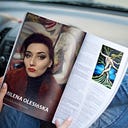Julian Stanczak — Op Art
The Op Art movement was named after his first major show, Julian Stanczak: Optical Paintings, held at the Martha Jackson Gallery in New York in 1964. His work was included in the Museum of Modern Art’s 1965 exhibition The Responsive Eye. In 1966 he was named a “New Talent” by Art in America magazine. In the early 1960s he began to make the surface plane of the painting vibrate through his use of wavy lines and contrasting colors in works such as Provocative Current (1965). These paintings gave way to more complex compositions constructed with geometric rigidity yet softened with varying degrees of color transparency such as Netted Green (1972).
In addition to being an artist, Stanczak was also a teacher, having worked at the Art Academy of Cincinnati from 1957–64 and as Professor of Painting, at the Cleveland Institute of Art, 1964–1995. He was named “Outstanding American Educator” by the Educators of America in 1970.Stanczak deployed repeating forms to create compositions that are manifestations of his visual experiences. Stanczak’s work is an art of experience, and is based upon structures of color. In the 1980s and 1990s Stanczak retained his geometric structure and created compositions with bright or muted colors, often creating pieces in a series such as Soft Continuum (1981; Johnson and Johnson Co. CT, see McClelland pl. 50). More recently, Stanczak created large-scale series, consisting of square panels upon which he examined variations of hue and chroma in illusionistic color modulations, an example of which is Windows to the Past (2000; 50 panels)
